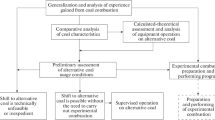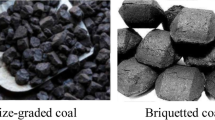Abstract
The article reports the results of investigation into the possibility of using off-design coals as an additional fuel in connection with predicted reduction in the heat of combustion of shale oil and more stringent environmental regulations on harmful emissions. For this purpose, a mathematical model of a TP-101 boiler at the Estonian Power Plant has been constructed and verified; the model describes the boiler’s current state. On the basis of the process flow chart, the experience of operating the boiler, the relevant regulations, and the environmental requirement criteria for evaluation of the equipment operation in terms of reliability, efficiency, and environmental safety have been developed. These criteria underlie the analysis of the calculated operating parameters of the boiler and the boiler plant as a whole upon combustion with various shale-oil-to-coal ratios. The computational study shows that, at the minimal load, the normal operation of the boiler is ensured almost within the entire range of the parts by the heat rate of coal. With the decreasing load on the boiler, the normal equipment operation region narrows. The basic limitation factors are the temperature of the steam in the superheater, the temperature of the combustion products at the furnace outlet and the flow rate of the combustion air and flue gases. As a result, the parts by heat rate of lignite and bituminous coal have been determined that ensure reliable and efficient operation of the equipment. The efficiency of the boiler with the recommended lignite-to-coal ratio is higher than that achieved when burning the design shale oil. Based on the evaluation of the environmental performance of the boiler, the necessary additional measures to reduce emissions of harmful substances into the atmosphere have been determined.
Similar content being viewed by others
References
A. Ots, Oil Shale Fuel Combustion (Tallinn, 2004).
V. T. Sidorkin, A. N. Tugov, V. A. Vereshchetin, and D. A. Mel’nikov, “Assessment of combustion of oil shale refinery by-products in a TP-101 boiler,” Therm. Eng. 62 (4), 271–277 (2015). doi: 10.1134/S0040363615040098
P. V. Roslyakov, R. Attikas, M. N. Zaichenko, K. A. Pleshanov, and I. L. Ionkin, “Studying the possibility of separate and joint combustion of Estonian shales and oil shale retort gas at thermal power plants,” Therm. Eng. 62 (10), 691–702 (2015). doi: 10.1134/S0040363615100082
A. A. Kniga, V. T. Sidorkin, and N. I. Rakitina, “Nitrogen oxides formation when burning anthracite fines in a pilot plant,” Therm. Eng. 39, (1), 29–31 (1992).
Heat Calculation of Boiler Aggregates (Normative Method), Ed. by N. V. Kuznetsov, V. V. Mitor, I. E. Dubovskoi, and E. S. Karasina, (Energiya, Moscow, 1973) [in Russian].
Calculation and Design of Dust-Preparation Units of Boiler Aggregates (Normative Materials), Ed. by N. V. Sokolov and M. L. Kisel’gorf, (NPO TsKTI, Leningrad, 1971) [in Russian].
Directive 2010/75/EU of the European Parliament and of the Council of 24 November 2010 on Industrial Emissions (Integrated Pollution Prevention and Control).
“Application program packet for calculation of thermal engineering equipment,” in Proc. Int. Sci.–Pract. Conf. “Boiler Designer-2014” (Toruss, Moscow, 2014).
O. M. Baldina, V. A. Lokshin, D. F. Peterson, I. E. Semenovker, and A. L. Shvarts, Hydraulic Calculation of Boiler Aggregates, Ed. by V. A. Lokshina D. F. Peterson, and A. L. Shvarts, (Energiya, Moscow, 1978) [in Russian].
RD 34.02.305-98. Methods of Determination of Gross and Specific Discharges of Harmful Substances in the Atmosphere from Heat Electric Station Boilers (VTI, Moscow, 1998) [in Russian].
RD 34.02.304-95. Methodical Directions on Calculation of Nitrogen Oxide Discharges with Fume Gases of Heat Electric Station Boilers (VTI, Moscow, 1996) [in Russian].
SO 153-34.02.304-2003. Methodical Directions on Calculation of Nitrogen Oxide Discharges with Fume Gases of Heat Electric Station Boilers (OAO VTI, Moscow, 2005) [in Russian].
Author information
Authors and Affiliations
Corresponding author
Additional information
Original Russian Text © P.V. Roslyakov, M.N. Zaichenko, D.A. Melnikov, V.A. Vereshetin, Raivo Attikas, 2016, published in Teploenergetika.
Rights and permissions
About this article
Cite this article
Roslyakov, P.V., Zaichenko, M.N., Melnikov, D.A. et al. Use of coals for cocombustion with Estonian shale oil. Therm. Eng. 63, 188–196 (2016). https://doi.org/10.1134/S0040601516030101
Published:
Issue Date:
DOI: https://doi.org/10.1134/S0040601516030101




